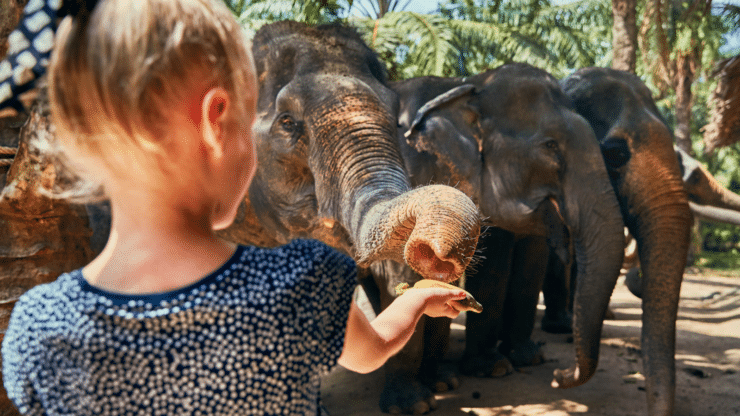Zoos and children often go hand in hand, with books, movies, and schools using them to teach kids about animals.
The big problem with this is that zoos are cruel to animals and teach kids that putting wild animals in captivity and using them for entertainment is ok.
No animal wants to be in prison for their entire life. That’s why so many zoo animals develop “zoochosis,” a form of psychosis where captive animals exhibit abnormal and repetitive behavior out of boredom, fear, and anxiety over being jailed for their entire lives with no escape.
This video from In Defense of Animals compares how elephants behave in the wild versus in captivity:
Wild Asian elephants can roam up to 50 kilometers (31 miles) in a day in search of food, water, and mates. They are very social animals who develop deep bonds with their herd.
In captivity, elephants develop abnormal behaviors such as swaying back and forth and pacing back and forth in enclosures that are way too small for them.
There is also a link between zoos and the global wildlife trafficking trade, which captures wild animals, steals babies from mothers, and puts wild animals at serious risk transporting them from their natural habitat to zoos and private collectors worldwide.
Thankfully, there are many places to see animals that are beneficial for the animals and promote compassion. Check out these five cruelty-free places to take your little animal lover!
1) National Parks
There are so many amazing national parks over the world. You can take your child to a national park that is close to you or one in another country. Going to a national park is a wonderful way for your child to have fun in nature while observing animals in their natural habitat.
2) GFAS Accredited Wildlife Sanctuaries
The Global Federation of Animal Sanctuaries (GFAS) is dedicated to ensuring that the animal sanctuaries and rescue centers that they accredit are true sanctuaries that rescue animals and do not breed them or use them for commercial purposes. Only go to accredited sanctuaries since many wildlife exploitation businesses lie and say they’re a sanctuary when they’re not.
ALSO: You Should Encourage Your Teen to Travel After High School
The animals in wildlife sanctuaries have been rescued and are either being rehabilitated to be released back into the wild or are being cared for because they can’t survive in the wild. Going to a wildlife sanctuary will teach your child about animals, the obstacles these animals face, and how to help conserve their habitat to prevent more animals from needing to be in sanctuaries.
3) Animal Shelters
According to the ASPCA, 6.3 million animals are sent to shelters in the U.S. alone. There are so many homeless animals that need a home, but adopting a cat or dog is a 10–20-year commitment and requires a lot of research and care. Only adopt an animal if your family can make that long commitment to that animal and can give them proper food, shelter, and love.
You don’t need to adopt an animal to visit a shelter. You can take your child to a shelter for the day to interact with the animals. If your child is very young, make sure that they interact with the animals safely and do not upset them, as young kids can be heavy-handed.
Older kids can volunteer and help out by playing with the animals, feeding them, bathing them, and helping them exercise.
4) Farm Sanctuaries
There are a lot of farm sanctuaries all over the U.S. and a few in other parts of the world. You can find the nearest GFAS-accredited farm sanctuary here.
Visiting a factory farm will teach your child the truth about animal farming and why it’s important to be compassionate for all species of animals. They will also see how playful, smart, and loving cows, chickens, and other farm animals truly are.
5) Eco-Tours
An eco-tour is a sustainable tour of a natural habitat or landscape. Experienced guides will take you around a natural area and teach you about local plants, wildlife, and culture. Many countries around the world offer eco-tours, but it’s important to do your research to make sure that the eco-tour you want to go on is actually eco-friendly and respectful of local people and wildlife. Eco-tours promote sustainable tourism, which is a great way to support local businesses in the area.
ALSO: My Child Hates School, What Can I Do?
You can check out the Global Ecotourism Network for a list of accredited eco-tours around the world.
There are so many ways to teach your child about animals that are compassionate and respectful of all living beings. By teaching children how to interact with animals and nature respectfully, you can save animals from being forced into captivity and help them stay wild and free.










Add comment